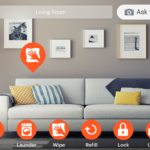[:en]A vacation rental inspection is critical before you start marketing any new property. You need to visit the property, check that everything is working as it should, and know how to resolve any problems the guests have using appliances and electronics quickly.
A thorough vacation rental inspection will also ensure you have an accurate record of what the property looked like before you started to rent it out to guests. This will help you make accurate claims to an insurance company if any damage occurs while a guest is in residence.
Here’s our handy guide to a thorough vacation rental inspection.
Check the Entry Method
Test out the entry method your guests will use and make sure it works correctly. Even if the owner offers to let you in with their key, use this inspection to try entering the property the way the guest will, whether it’s by using a keypad, a lockbox, or a handoff.
For keypads and lockboxes, make sure the codes work correctly and note any special quirks of the entry system that the guest will need to know. If the keypad takes a few seconds before the door registers the code and unlocks, for example, make sure your guests know that in the check-in instructions.
If the key is old or sticks in the lock, recommend to the owner that they have a new key made or new locks fitted. Entry issues are a huge problem for guests, and the issue will only get worse the more visitors you have. Be sure your entry method works correctly and will work reliably for guest after guest.
Turn On Every Switch and Faucet
Test every light switch in the house, room by room. Immediately, you should be able to see which rooms have light bulbs that need replacing. Be sure to check that all bulbs in all fixtures are working – an overhead fixture may work, for example, but if there are supposed to be two bulbs in the fixture and only one comes on, it’s not going to look very professional.
If you know the owner doesn’t frequently use the property, you might take advantage of the inspection to simply replace all of the light bulbs with new ones. If you use energy-efficient bulbs, you’ll not only help the owner save on energy bills, but you’ll also save some effort: you won’t have to replace them again for several years.
Check that all bulbs in all appliances match. Many bathroom vanities come with a row of light bulbs, for example, and it looks unprofessional to have some clear bulbs and some frosted ones. Swap them out for matching ones, and you’ll give your guests better light and enhance the property’s appeal.
Mark any switches that turn on outlets rather than overhead fixtures. Some outlets only work when a switch is turned on, and this can confuse guests and cause issues. You can notify your guests in any number of ways – a note in the guest book, a small sign next to the fixture – but be sure they realize that when the switch is off, a device plugged into that outlet will no longer charge.
Finally, turn on every faucet in the house. Be sure to check that the shower head doesn’t spray in all directions, and that the hot taps in the kitchen and bathroom actually produce hot water. Look under the sink for drips or leaks. If you find any, those will need to be repaired before your guests arrive!
Learn How to Use Every Appliance
Your vacation rental inspection should include checking to be sure all appliances function, which means you’ll need to know how they’re supposed to work. If you don’t know how to use the dishwasher, after all, you won’t be able to tell if it’s broken or simply on the wrong setting.
This gives you a great opportunity: while you’re checking to be sure all the appliances work, write down instructions for their use. That way, you’ll have a handy reference when guests are having trouble using the appliances, and you’ll be able to include instructions in the guest book.
This extra step can keep guests from thinking appliances are “broken” when they aren’t. With step-by-step instructions, they’ll probably be able to figure out unfamiliar appliances with minimal confusion.
You’ll need to know how to use the:
- Oven and stovetop
- Washer and/or dryer
- Thermostat and/or air conditioner
- Dishwasher
- Microwave
- Coffee maker and/or cappuccino machine
- Hot tub
The oven and stovetop may seem straightforward, especially if they’re similar to the ones you have in every vacation rental and your own home. But guests visiting from another country may find them very confusing.
For example, most ovens in Europe use a number system to tell you how hot the oven is, with dial instructions that look like this: Lo / 1 / 2 / 3 / 4 / 5 / 6 / Hi. In the United States, most ovens are marked with the temperature in degrees Fahrenheit: Warm / 200 / 250 / 300 / 350 / 400 / 450.
An American visiting a vacation rental you manage in Barcelona isn’t going to know how hot an oven set to the “3” setting is, and a citizen of the EU isn’t going to know whether 300 correlates to the “3” or the “4” setting on the stoves they’re used to.
For all appliances, write down step-by-step instructions on their use and test them out yourself. Follow your instructions precisely, imagining this was the only information you had. Would you be able to use the appliances? If not, keep going until your instructions are as clear as you can make them.
Turn on All Electronics
Turning on the TVs is a start, but it’s only the beginning of a thorough vacation rental inspection. You want to be sure your guests can actually access all of the electronics you’ve promised they will be able to use. If you advertise that your properties come with cable, for example, be sure that each TV is connected to cable channels.
You should also check DVD players, stereos, and video game systems, if you’ve provided them.
Last but certainly not least: check the internet connection. Bring a smartphone or table into every room in the house and try playing a video on it while connected to the internet. Be sure the internet is functional in all rooms, and suggest purchasing a booster to the owner if it’s very faint in some of the rooms of the house.
Internet is essential for most travelers today, and can often be a huge problem for those who are traveling on business. Avoid bad reviews by being sure the internet will function as expected.
Finally: as with the appliances, this is a good time to write down step-by-step instructions on how to use all of the electronics. If you need to turn to a certain channel to use the DVD player, for example, make sure your guests know that and have simple instructions to follow.
Check All Safety Precautions
Look at all of the smoke and carbon monoxide detectors to be sure they’re functional, and replace the batteries in all of them. Nothing will guarantee a bad review like a guest waking up in the middle of the night to an ongoing “beep” telling them to replace a battery!
Check to be sure there is a new fire extinguisher in the kitchen and by any outdoor cooking appliances like barbeques. It’s also good to provide a small first aid kit in the bathroom for basic supplies like bandages or burn ointment.
This is a short check, but a critical one. Every vacation rental inspection must include safety measures.
Note All Damage
This will be by far the lengthiest portion of your vacation rental inspection, but it’s well worth it. You’ll want to note all the existing damage in the property and make recommendations to the owner if you think the damage needs to be remedied before your first check-in.
Pictures are your friend! It may help to write down any damage for easy reference by room, but for insurance purposes, photos will be extremely useful. Snap a quick photo of any damage. If the damage is on a large space like the floor or the wall, be sure to get enough of the surrounding room in the shot to make it clear where the damage is located.
- Walls. Give the walls a visual inspection and note any scrapes, discoloration, or marks. If the paint job looks dingy or has many marks on it, you may want to recommend a repaint before your first guests arrive.
- Fixtures. If any bathroom or kitchen fixtures have leaks, recommend to the owner that they be repaired before a guest arrives. Be sure to mark down any damage, such as cracks or discoloration, on the fixtures themselves.
- Furniture. Check every piece of furniture from every angle, even those that are against the wall. Even damage minor enough that a guest wouldn’t notice should be marked down – you don’t want to accidentally accuse a guest of damage they didn’t cause.
- Floors. Floors often have so many small scratches that it’s pointless to try to catalogue all of them. It can be simpler to take pictures of every few feet of flooring so that you have a record of the difference between the mild scratch that was already there vs. the huge scrape that a guest left behind.
- Appliances. Appliances often pick up a bit of wear and tear, so be sure to write down any scrapes or scratches that already exist. If an appliance is looking particularly run-down, you might recommend the owner consider replacing it.
You’re all done! Once you’ve finished this last part of your vacation rental inspection, you should be confident that guests will have a flawless stay in the property.
What happens if your cleaning service notices damage to the property while they’re performing the post-stay clean? With the Properly app, they can take a picture and notify you of the issue in real time – giving you lots of time to fix the issue before the next guest arrives. Learn more about Properly here.
[:]



